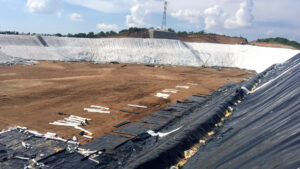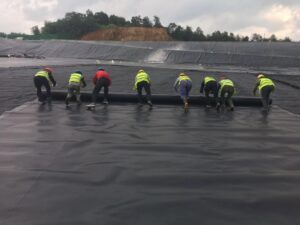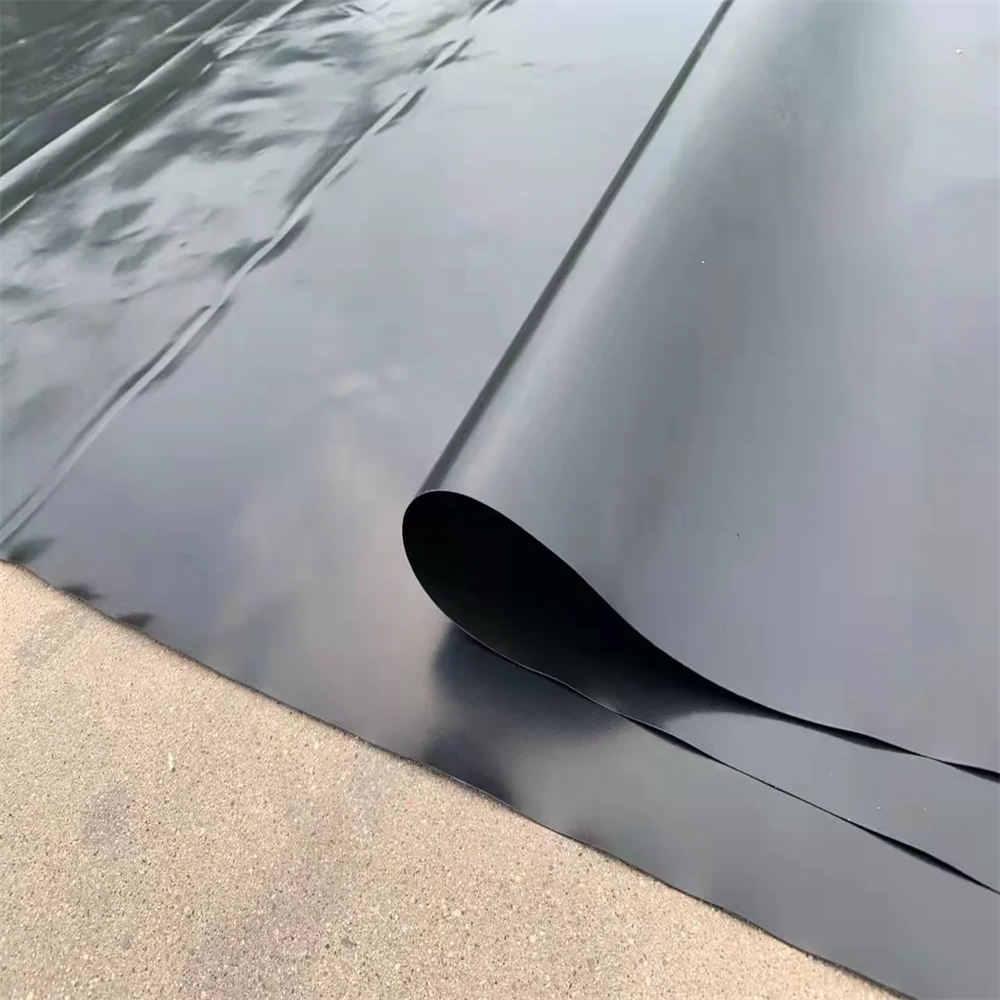Geomembrane tensile testing equipment
Electronic Tensile Testing Machine: An electronic tensile testing machine is a widely used device used to measure physical properties such as tensile strength, elongation at break, and elastic modulus of materials. It calculates a material’s stress-strain curve by applying a tensile force and simultaneously measuring force and displacement. This equipment is commonly used in standard tensile tests to evaluate the tensile properties of geomembranes.
Uniaxial stretching machine: The uniaxial stretching machine is a device specially used to test the uniaxial stretching performance of geomembranes. It can apply a continuous tensile force in one direction and measure the stress and elongation of the geomembrane.
Biaxial stretching machine: Biaxial stretching machine is used to apply vertical and horizontal stretching force at the same time. This equipment can be used to simulate the multi-directional tensile forces that geomembranes are subjected to in practical applications to evaluate the performance of geomembranes in all directions.
Gas stretcher: A gas stretcher (or inflatable stretcher) is a special equipment used to test inflatable geomembranes. It is capable of applying internal air pressure and tensile forces and measuring the expansion, deformation and destructive properties of the inflatable geomembrane.
These tensile testing machines are typically equipped with various sensors, data acquisition systems, and software for controlling tensile force and collecting experimental data.
By using these devices, the performance of geomembranes under tensile loading can be quantitatively evaluated, including tensile strength, elongation, elongation at break, etc.

Geomembrane gas detection equipment
Geomembrane gas detection tools are usually used to detect gases under or around geomembranes to ensure that no increase in harmful gas concentrations occurs during construction or use. The following are some common geomembrane gas detection tools and related detection methods:
Gas Detection Instruments: Gas detection instruments are critical tools for measuring and monitoring gas concentrations. These instruments can detect a variety of gases, including but not limited to oxygen, carbon dioxide, methane, hydrogen sulfide, and volatile organic compounds (VOCs). Gas detection instruments are often equipped with sensors and displays that can display gas concentrations in real time and sound alarms when dangerous levels are reached.
Gas probe: The gas probe is one of the components of the gas detection instrument and is used to collect gas samples and send them to the instrument for analysis. Probes typically have long, flexible tubes that allow the probe to be inserted into the space under or around the geomembrane to sample.
Gas Sampling Bags: Gas sampling bags are used to collect gas samples and then send the samples to a laboratory for analysis. This is very useful for detecting some special gases or performing more precise gas analysis.
Multi-parameter instruments: Some instruments can measure multiple parameters, including gas concentration, temperature, humidity, and air pressure. This is useful for a comprehensive assessment of the gas environment, as these parameters may influence each other.
Gas Detection Kits: Gas detection kits typically include multiple tools and instruments used to perform comprehensive gas testing. These kits may include gas detection instruments, gas probes, gas sampling bags, standard gas samples and associated safety equipment.
When using geomembrane gas detection tools, be sure to follow the following safety guidelines:
Understand the types of gases that need to be detected and make sure to choose the appropriate detection instruments and probes.
Conduct gas testing before entering enclosed spaces or underground construction to ensure no hazardous gases are present.
Record and monitor changes in gas concentration and whether safety limits are exceeded.
Wear appropriate personal protective equipment such as a respirator and protective glasses.
When test results indicate the presence of hazardous gases, take appropriate safety measures, such as ventilation, evacuation, or walk-through air purification equipment.

When welding geomembranes, quality inspection tools can be used to evaluate the quality and sealing performance of the weld. The following are several common geomembrane welding quality inspection tools:
Visual inspection of welds: After welding is completed, visual inspection of welds is one of the simplest and most commonly used quality inspection methods. Use the naked eye or an auxiliary tool such as a magnifying glass or microscope to inspect the weld for completeness, uniformity and freedom from defects. Check the welds for bubbles, cracks, unmelted and weak joints.
Tensile Strength Test: Tensile strength testing is used to evaluate the strength of welds. This test requires the use of a tensile testing machine or similar equipment to stretch the sample at the weld to measure the maximum tensile strength of the weld. The quality of the weld is evaluated by comparison with standard values.
Pressure Test: Pressure testing is used to evaluate the sealing performance of welds. After completing the welding, apply a certain amount of pressure to the welding joint and use a pressure gauge or leak detection instrument to detect whether there is pressure loss or leakage. This can help determine if the weld has a good seal.
Thermal imaging inspection: Thermal imaging inspection uses infrared thermal imaging cameras to detect the heat distribution of welds and surrounding areas. By observing the heat map, you can identify whether there are abnormal points or uneven heat distribution in the weld to evaluate the quality of the weld.
Hydrostatic test: Hydrostatic test is used to detect whether the weld has good waterproof performance. After completing the welding, apply water pressure to the weld and observe if there is any water leakage or penetration. This can help evaluate the sealing performance of the weld.
Author
-

Founded in 2002, Tinhy's team focuses on the manufacturing, marketing, installation, application and research and development of geosynthetic materials.
View all posts




